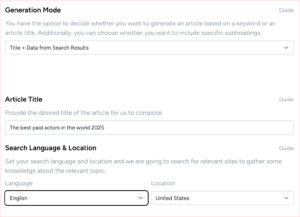You’ve likely noticed how chaotic managing content can become without a structured system in place. Whether you’re dealing with inconsistent information, duplicate files, or a lack of accountability, the chaos can quickly overwhelm you and your team.
Enter content management governance—a structured approach to managing your digital content that ensures consistency, accuracy, and accountability.
In this step-by-step guide, you’ll discover practical strategies to build a robust content management governance framework tailored to your organization’s unique needs. You’ll explore how to:
- Set clear roles and responsibilities
- Establish effective workflows
- Implement policies that keep your content organized and compliant
By the end of this guide, you’ll have the tools and knowledge to transform your content management processes, making your operations more efficient and your content more reliable.
Ready to bring order to your digital world? Let’s dive in and start building your content management governance step-by-step.
Understanding Content Management Governance
Content management governance ensures that your organization’s content is accurate, compliant, and effectively managed.
Imagine the joy of knowing every piece of content you produce is top-notch and fully compliant. Governance is like the secret sauce that binds everything together, making sure your content management processes run smoothly and efficiently.
You’ll find that governance isn’t just a set of boring rules; it’s a dynamic framework that empowers your team to create, manage, and distribute content without fear of compliance issues. It helps you establish clear guidelines and standards that everyone can follow, reducing errors and enhancing overall quality.
By embracing content management governance, you’re not just ticking boxes for compliance. You’re creating a joyful, seamless experience for your team and audience alike.
Think of it as the backbone that supports your content strategy, ensuring every piece of content contributes to your organization’s goals.
Dive in, and you’ll see the magic unfold.
Identifying Key Stakeholders
Every successful content management governance strategy starts with identifying the key stakeholders involved.
You’ll want to gather a diverse crew who can bring different perspectives to the table. Think about who in your organization deals with content on a daily basis. These could be:
- Marketing mavens
- IT wizards
- Compliance gurus
- Customer service champions
Each stakeholder will have unique insights that can enrich your content management efforts. By involving them early, you ensure that your governance strategy is not only robust but also enjoyable to implement.
Together, you’ll craft policies that are both effective and delightful to follow, ensuring compliance without feeling like a chore.
Don’t forget to consider external stakeholders too. Partners, clients, and even regulatory bodies can offer valuable input that keeps your content management practices both compliant and user-friendly.
Remember, the joy of governance lies in collaboration and shared success.
So, gather your key players and let’s make content management a pleasure!
Defining Roles and Responsibilities
Clearly defining roles and responsibilities ensures everyone knows exactly what they’re accountable for in the content management process. This clarity brings a sense of joy and efficiency to your team, making sure each member feels valued and essential.
For a thriving content management governance, assign roles such as:
- Content Creators
- Editors
- Compliance Officers
Content Creators can focus on the delightful task of generating engaging material.
Editors then step in to polish the content, ensuring it aligns with your brand voice and quality standards.
Compliance Officers play a crucial role in maintaining governance by ensuring all content adheres to relevant laws and regulations. This prevents potential issues and keeps your organization compliant.
By defining these roles clearly, you foster a harmonious and productive environment where everyone knows their part. This structure not only enhances efficiency but also brings a sense of purpose and joy to your team, making the content management process a truly rewarding experience.
Establishing Content Guidelines
To ensure consistency and quality across all your content, it’s essential to establish clear and comprehensive content guidelines. You’ll find that having these guidelines not only boosts your content management efforts but also infuses joy into your team’s creative process.
Begin by defining your tone and style, ensuring they align with your brand’s identity. This step is crucial for maintaining content governance and making sure every piece resonates with your audience.
Next, outline the types of content that should be produced, and include specifics on:
- Formatting
- Language
- Imagery
This helps keep everyone on the same page and ensures compliance with your brand’s standards.
Don’t forget to incorporate SEO best practices to enhance discoverability.
Finally, make your guidelines accessible to everyone involved in content creation. By doing so, you’ll create a unified approach to content management that delights both your team and your audience.
With these guidelines in place, you’re setting the stage for a seamless, joyful content creation process.
Implementing Approval Processes
To ensure your content meets established guidelines, implement a streamlined approval process that involves key stakeholders at every stage. This approach not only ensures compliance but also brings a sense of joy and satisfaction to your team as they see their contributions valued and validated.
Start by defining clear roles within your content management system:
-
Identify who will review, approve, and give the final nod for publication.
-
By involving key stakeholders, you enhance governance and ensure that each piece of content aligns with your organizational standards.
Use automation tools to simplify the workflow, making it easy and enjoyable for your team to participate:
- Set up notifications and reminders to keep everyone on track without feeling overwhelmed.
This streamlined process maintains content quality while fostering a collaborative and positive environment.
Remember, the goal is to create a seamless experience that combines effective governance with the pleasure of producing high-quality content. Consistent, compliant content is not just a task; it’s a joyful journey of collective effort and achievement.
Creating a Content Calendar
A well-structured content calendar is your roadmap to consistent and timely content production. It’s not just a tool; it’s your secret weapon in mastering Content Management.
Picture your calendar as a vibrant tapestry where every thread represents a piece of engaging content, seamlessly woven together.
Start by brainstorming content ideas that align with your brand’s voice and values. This ensures you’re not only delivering joy to your audience but also maintaining Governance and Compliance.
Organize these ideas by mapping them out over weeks and months. This foresight helps you:
- Anticipate busy periods
- Align with key events or holidays
Set realistic deadlines for each phase of content creation, from drafting to publishing. This keeps your team on track and prevents last-minute scrambles.
A shared content calendar fosters collaboration, making sure everyone’s in sync.
Remember, a well-planned calendar isn’t just about dates; it’s about creating a rhythm that delights both your team and your audience.
Ensuring Compliance with Policies
Ensuring adherence to company policies is crucial for maintaining the integrity and trustworthiness of your content. By prioritizing compliance within your Content Management system, you’ll foster a structured and reliable environment.
Governance is all about creating clear rules that everyone follows, ensuring your content not only shines but is also consistent and safe.
Embrace the joy of knowing your content is well-governed and compliant by establishing straightforward guidelines. Make it a delightful experience for your team to understand and implement these policies. Regularly update and communicate these guidelines, so everyone stays on the same page. This proactive approach minimizes risks and enhances the quality of your content.
Incorporate compliance checks in your workflow to catch potential issues early. This can be as simple as a checklist or as sophisticated as automated tools that flag non-compliance.
Remember, a well-governed content strategy isn’t just about rules—it’s about creating a harmonious ecosystem where creativity and order coexist beautifully.
Monitoring Content Performance
Regularly tracking the performance of your content ensures that you’re meeting your goals and can make data-driven improvements.
Dive into the joy of seeing your hard work pay off as you watch your content thrive. Effective content management isn’t just about creating; it’s about understanding how your audience engages with what you’ve created.
By closely monitoring metrics like views, shares, and comments, you’ll uncover which pieces resonate most.
This insight lets you refine your strategy, keeping your content fresh and exciting. Governance is key here—ensure that your tracking methods align with your organization’s policies and compliance standards.
Embrace tools that offer robust analytics, giving you a clear picture of your content’s impact.
- Celebrate the small victories each time your content hits a milestone.
- Consistently reviewing performance not only boosts your confidence but also cements your commitment to excellence in content management.
Remember, in the vibrant world of content, staying informed is your secret to sustained success.
Conducting Regular Audits
Regular audits help you maintain the quality and relevance of your content.
By routinely evaluating your content management practices, you’ll ensure that your governance framework stays effective and aligned with your goals. Imagine the satisfaction of knowing your content is always up-to-date, engaging, and compliant with industry standards.
Start by setting a schedule for your audits.
Quarterly reviews are a great place to begin. During these audits, check for:
- Outdated information
- Broken links
- Compliance with your governance policies
Use automated tools to streamline the process and make it more enjoyable.
Next, involve your team in the audit process.
Collaboration not only makes the task more fun but also brings diverse perspectives to the table. Encourage them to:
- Share insights
- Suggest improvements
Finally, document your findings and take action.
Immediate fixes keep your content fresh and your audience delighted. Regular audits in content management governance make the entire process smoother, more efficient, and ultimately more joyful for everyone involved.
Adjusting Governance Structure
Taking a proactive approach to adjusting your governance structure ensures it remains effective and adaptable to changing needs.
Embrace the joy of refining your Content Management strategies by regularly evaluating and tweaking your governance framework. This process isn’t just about maintaining compliance; it’s about crafting an environment where content flows seamlessly and effortlessly.
Start by identifying any areas where your current governance might be falling short.
- Are there bottlenecks in content approval?
- Is compliance becoming more challenging?
Address these issues head-on. Involve your team in brainstorming sessions to gather fresh insights and innovative solutions. Their input can be invaluable in creating a governance structure that’s both robust and flexible.
Next, update your policies and guidelines to reflect these changes.
- Make them easy to understand and accessible to everyone involved.
Remember, governance should empower, not restrict.
By continuously adjusting your Content Management governance structure, you’re not just keeping up with changes; you’re setting the stage for a smoother, more joyful content journey.
Continuous Improvement Efforts
Regularly evaluating your processes ensures that your content management system remains efficient and effective.
Continuous improvement efforts are essential for maintaining the joy and satisfaction that come from a well-governed and compliant system.
Start by setting up periodic reviews of your content management processes. This helps you identify areas where you can streamline workflows or enhance governance protocols.
Engage your team in these evaluations to gain diverse perspectives:
- They’ll likely spot opportunities for improvement that you might have missed.
Keep an eye on compliance requirements, ensuring you’re always up to date with the latest regulations:
- This proactive approach helps you avoid headaches down the road.
Don’t underestimate the power of feedback. Encourage users to share their experiences and suggestions:
- Their insights are invaluable for refining your system.
Embrace a culture of continuous learning and adaptation, and you’ll find that your content management governance not only meets but exceeds expectations:
- This creates an environment filled with efficiency and pleasure.
How can technology tools assist in streamlining content management governance?
Technology tools can be your best friend in simplifying content management governance!
They help you organize, protect, and control your content effortlessly.
With tools like automated workflows and AI-powered analytics, managing your content becomes a breeze.
Automated workflows ensure efficiency by streamlining repetitive tasks.
AI-powered analytics provide insights that can help in making informed decisions.
These tools ensure efficiency, compliance, and security, making your job a whole lot easier.
- Efficiency: Streamline processes and reduce manual effort.
- Compliance: Ensure adherence to regulations and internal policies.
- Security: Protect sensitive information from unauthorized access.
Embrace the power of technology to streamline your content management governance and enjoy the peace of mind it brings!
What are the common challenges faced during the initial implementation of content management governance?
When starting content management governance, you might face challenges like defining clear roles, setting up effective communication channels, and ensuring everyone is on the same page.
But don’t worry, with a positive attitude and a willingness to collaborate, you can overcome these obstacles and create a smooth process that benefits everyone involved.
Remember, teamwork and a sprinkle of creativity can turn these challenges into exciting opportunities for growth and success!
How do you measure the return on investment (ROI) for content management governance initiatives?
To measure ROI for content management governance initiatives, follow these steps:
1. Define Clear Goals:
- Establish what you aim to achieve with your initiatives.
2. Track Improvements:
- Monitor enhancements in content organization.
- Observe user engagement levels.
- Evaluate efficiency gains.
3. Use Analytics:
- Track key metrics such as:
- Content performance
- Workflow productivity
4. Assess Cost Savings:
- Identify savings from streamlined processes.
- Note reductions in errors.
5. Celebrate Wins:
- Highlight successes like:
- Increased user satisfaction
- Faster content delivery
6. Remember:
- ROI isn’t just about numbers—it’s about the joy of seeing your efforts make a positive impact!
Conclusion
In conclusion, you’ve laid the foundation for effective content management governance by understanding key concepts, defining roles, and implementing processes.
Key Concepts:
- Understanding the principles of content management governance.
- Recognizing the importance of content quality, compliance, and performance.
Defining Roles:
- Assigning clear responsibilities to team members.
- Establishing accountability for content creation, review, and publishing.
Implementing Processes:
- Create a content management plan.
- Define workflows and approval processes.
- Set up tools for monitoring and analytics.
By following the outlined steps and remaining vigilant in monitoring and adjusting your governance structure, you’re on track to ensure content quality, compliance, and performance.
Final Thoughts:
Keep up the good work and continue striving for excellence in your governance efforts.





